Welcome to Hadar: a village under siege
... by al-Qaeda and Israeli forces alike
The village of Hadar, in Southern Syria, is buttressed on one side by Israeli watchtowers and walls – and endures deadly attacks from jihadist Syrian rebels from the other three.
HADAR, SYRIA — Situated in the northern part of Quneitra governorate, with the towering Jabal al-Sheikh (Mt. Hermon) overlooking it and the region, Hadar is in both a beautiful area of Syria and a dangerous one.
The roughly 10,000 defiant villagers of Hadar are isolated and under constant threat of attack. Until December 2017, Hadar was surrounded on three sides by terrorists and was attacked many times.
Positioned in a valley, with the al-Qaeda alliance until December 2017 occupying Beit Jinn and other villages to the east, Hadar also borders the ceasefire line of the occupied Syrian Golan, an area teeming with still more al-Qaeda terrorists. From their positions inside the United Nations Disengagement Observer Force (UNDOF) zone of the occupied Syrian Golan, terrorists in Jubata al-Khashab (roughly 6 kilometers directly south of Hadar), Turunjah (roughly 5 kilometers south of Hadar), and Ufaniyah (further south than Jubata al-Khashab), have fired mortars, missiles, and other explosives on Hadar, something acknowledged even by the UN Secretary-General.
In his December 6, 2017 report, the Secretary-General noted that terrorist groups fighting in the UNDOF area of operation include “the listed terrorist group Jabhat Fath al-Sham (formerly the Nusra Front) and Jaysh Khalid Ibn al-Walid, which pledged allegiance to the Islamic State in Iraq and the Levant (ISIL).”
The same report noted the attacks from the three villages towards Hadar were preceded by a “vehicle-borne improvised explosive device,” which killed nine people. In Hadar, I would learn that the car bomb didn’t just target “a pro-Syrian forces checkpoint in Hadar,” as per the UN report, but was headed towards the heart of the village when shot at by Hadar defenders. The vehicle exploded less than 100 meters from a school, at 9 a.m., according to Hadar resident Mahmoud Taweel. Had the village not been on alert, and families staying at home, the number killed would have surely been higher and included many children.
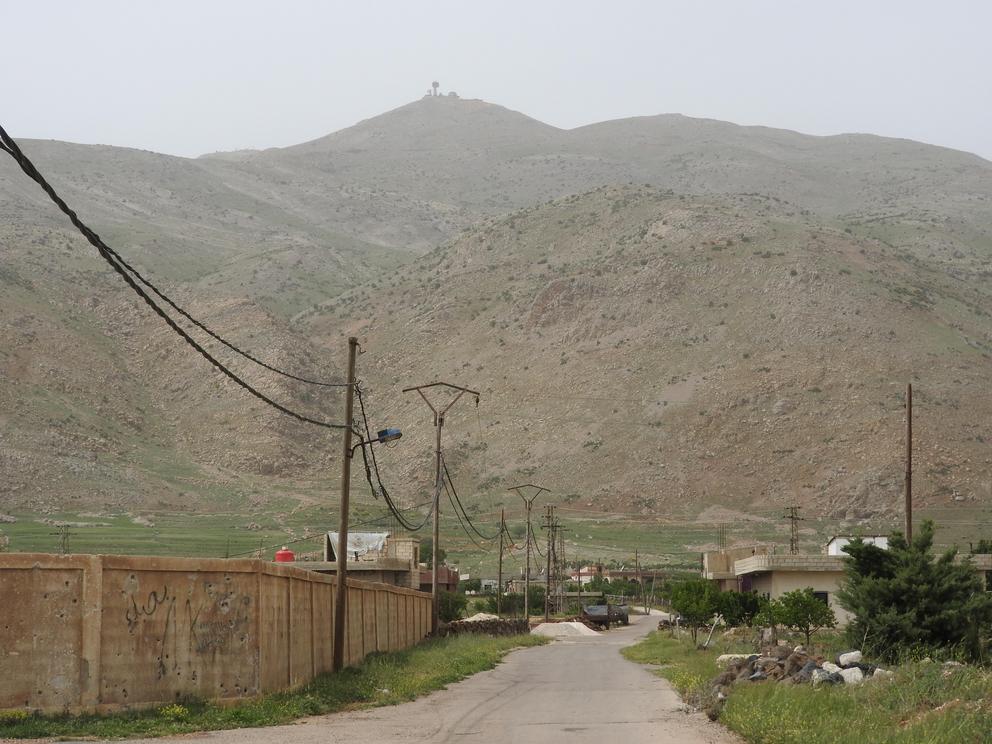
The road leading to the site of the deadly, Nov 2017 suicide car bomb. An Israeli observation post is visible atop in the mountain in the background. Eva Bartlett | MintPress News
Most recently, on June 16, Syrian state media, SANA, reported that terrorists in Jubata al Khashab, “set fire once again to a large area of agricultural lands in the vicinity of Hadar village,” burning acres of fruit orchards south of the village. SANA further reported that firefighters were unable to reach the area to quell the fire, devastating the farmland and depriving landowners of their prime source of income.
The support of Hadar villagers for their army and president is unsurprising, given these are the two bodies that have protected them and supported them against attacks from al-Qaeda and Israel, next door to Hadar.
According to a report by Syrian journalist Alaa Ebrahim, the last attack on Hadar was on November 3, 2017, “… a ground offensive in three different directions, in an attempt to take the last few kilometers the government still controls along the border with Israel.” The Syrian army, Ebrahim noted, controls only five kilometers of the border with Israel and is limited in the number of military units it can move to the area, under the disengagement agreement reached following the 1973 war with Israel.
Mr. Taweel explained that people of his town view Jabal al-Sheikh as a symbol of blessings. On top of that same mountain, Israeli observation posts oversee all activity. Hadar residents and Syrian soldiers believe that Israel has been coordinating with terrorist groups in their attacks on the village. Given that UNDOF forces themselves have documented Israeli soldiers interacting with terrorists in the occupied Syrian Golan, and given that Israel has attacked Syria on numerous occasions, the belief that the Israelis are aiding al-Qaeda terrorists in attacks on Hadar is more than reasonable.
The corporate media silence on Hadar, in spite of what the villagers have endured and continue to face, would be surprising if it wasn’t already clear that corporate media isn’t interested in highlighting these kinds of Syrians. Just as they dismiss narratives of Syrians who do not support any of the terrorist factions, so have they corporate media dismissed narratives of Syrians who are proud supporters of the Syrian army and the democratically-elected president and Syrians whose experiences defy outside claims of a “civil war,” “revolution,” or “sectarian conflict.”
“Our farmers can’t reach their land”
On May 4, in a hired taxi and with a translator, I headed for Hadar to meet with Mahmoud Taweel, an English teacher, who would also introduce me to other Hadar residents, to hear from them on the attacks they’ve endured and the threats they’ve fought off, along with the Syrian army — largely to the silence of corporate media.
Along the way, our taxi was joined by a car of four Syrian soldiers, who accompanied us both to show us the safest route to Hadar and also to protect us should terrorists in surrounding areas attack.
We drove along a road flanking a heavily fortified UN base for a brief period, then followed another road cutting through open fields, Jabal al-Sheikh in the distance, finally descending along a narrow road winding its way through endless fruit-tree orchards before entering Hadar.
In the town square, I chatted with a woman and man in a small shop until Mr. Taweel arrived. After a five minute walk, we reached his stone house, surrounded by fruit and other trees and adorned with yellow rose bushes.
Watch | Hadar resident Mahmoud Taweel on life under threat from terrorism
I asked Mahmoud Taweel to speak about life in Hadar over the past years. He said, of the terrorists south of Hadar and those formerly east of the town:
They have been terrorizing us, by shelling, mortars. The most important thing is that they are depriving us of reaching our fertile farms. Ninety percent of our civilians depend on farming for their living. But our farmers can’t reach their land.”
I was struck by the similarity of the situation of Palestinian farmers and these Hadar villagers. In the case of Palestinians, it is Israeli illegal colonists and soldiers who violently prevent them from accessing their lands, whether in West Bank areas of occupied Palestine or in the tiny and all too familiar Gaza Strip.
Having worked for years with farmers in Gaza and also in the West Bank, with the violent Israeli tactics of shooting live ammunition to harass farmers off their land. This harassment has killed dozens of farmers and maimed many more. The situation in Hadar isn’t much different, except al-Qaeda and other terrorists do the attacking, bombing and burning of farmland and killing of villagers.
Many maimed, many martyrs
Hadar has a population of around 10,000, according to Mahmoud Taweel. I asked him about those injured and killed by terrorist attacks. He replied:
Too many people were killed. At least 130 martyrs, and around 400 injuries and casualties. Some of them are hopeless cases: they can’t walk, speak, talk, and they need a very intensive health care on a daily basis.”
So I asked him whether there is a hospital in the town to provide the needed health care to the injured:
No hospital in Hadar, just a small mobile clinic with insufficient equipment. Ambulances took injured to Damascus, always under the threat of sniping from terrorists on either side.”
Additionally, Hadar has suffered periods of no electricity. “Three months with no power at all,” Mr. Taweel said. “And the moment that the government restores power, the terrorists shell and destroy it…to make us live in darkness.”
Mr. Taweel said Hadar village has two high schools, two primary, two intermediate, and one kindergarten. We drove to one of the schools, the one near to the site of the November 3, 2017, suicide car bombing just at the northern edge of Hadar. Mr. Taweel pointed to a deep rut in the road, now filled in with gravel, saying that was where the suicide bomber had detonated the explosives. Some meters away, the ruins of a small shop.
Zooming in on the Israeli observatories overlooking Hadar, I asked whether they believed Israel had a role in the attacks that day.
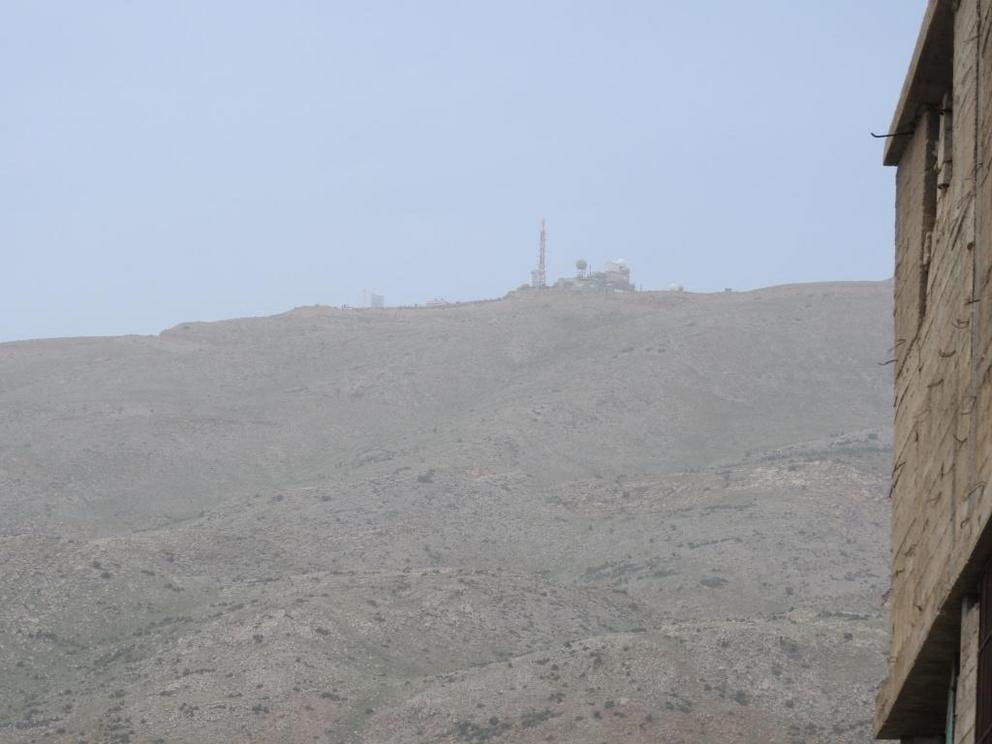
One of the two Israeli observation posts overlooking Hadar, Syria. Eva Bartlett | MintPress News
“For sure,” Mr. Taweel replied, “The final battle on November 3 was schemed, planned, and supported by Israel.”
In his November 5, 2017 report, Alaa Ebrahim interviewed a Syrian army official who said: “Militants and Israel prepared this assault for three months and were thwarted in two hours.”
By mid-December, Syrian army units recaptured areas to Hadar’s northeast that had been occupied by al-Nusra. By the end of December, following military operations by the Syrian army and local defenders, terrorists were evacuated from Beit Jinn (to Hadar’s east), part of a deal to restore peace to that area. By January 2018, families who had been displaced from Beit Jinn and surrounding areas were returning. The restoration of security to Beit Jinn and surrounding areas also, importantly, meant one less front from which terrorists could attack Hadar. Terrorists remain in areas south of the village, and continue their attacks.
Facing occupied land
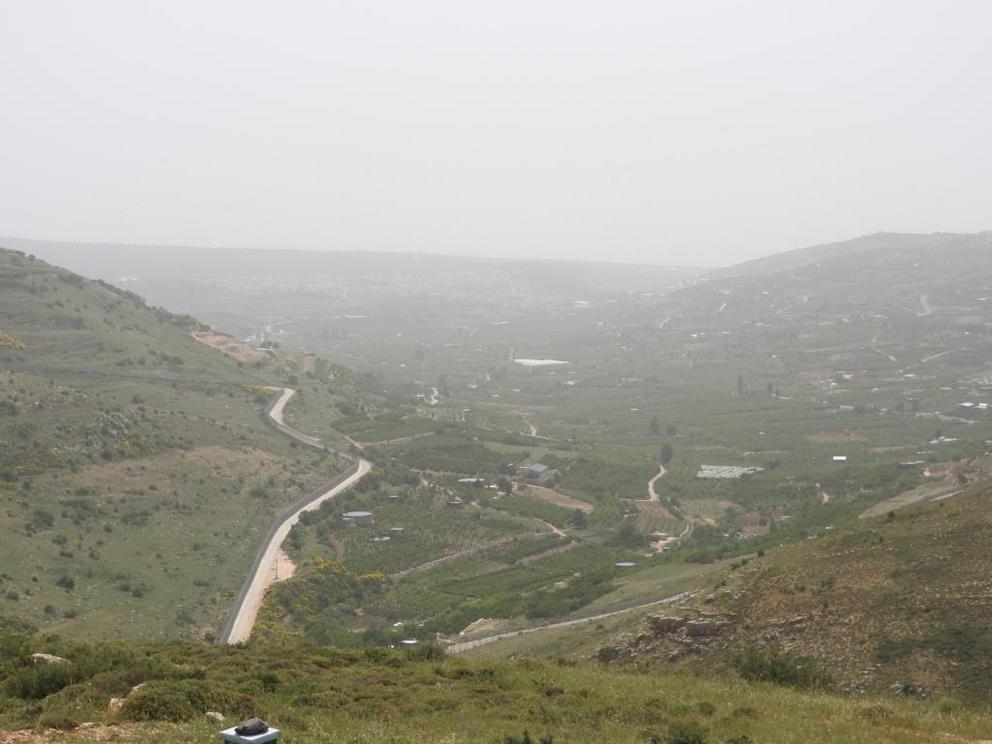
An Israeli road, heavily fortified, cuts through Syrian land on both sides in the occupied Golan Heights. Eva Bartlett | MintPress News
Descending the winding road a few kilometers to the west of Hadar, the hills of Majdal Shams, in the occupied Syrian Golan, appeared. Between the hill I stood on and Majdal Shams, an Israeli road fortified by a fence sliced the two Syrian lands, securing the land Israel has stolen and illegally occupies.
The Syrian mission to the UN post on the occupied Syrian Golan reads:
…[T]he Golan was home to over 140,000 Syrians, most of whom were driven out of their homeland and into Internally Displaced Persons (IDPs) status. Till this day, almost 40 years later, the Syrian inhabitants of the Golan are still unable to return to their homes, towns and cities. Today these Syrians exceed 500,000 people. Some Syrians remained in the Occupied Syrian Golan and continue to live in small villages amounting to approximately 20,000 Syrians.
Most of the Syrian cities, towns and villages in the Golan were destroyed by Israeli occupation forces, who in turn have built over 40 illegal settlements despite all international condemnation. Israel continues not only to occupy the Syrian Golan but to also destroy its ancient ruins and geopolitical atmosphere for the sole purpose of cleansing the Golan of its Syrian people and their history.”
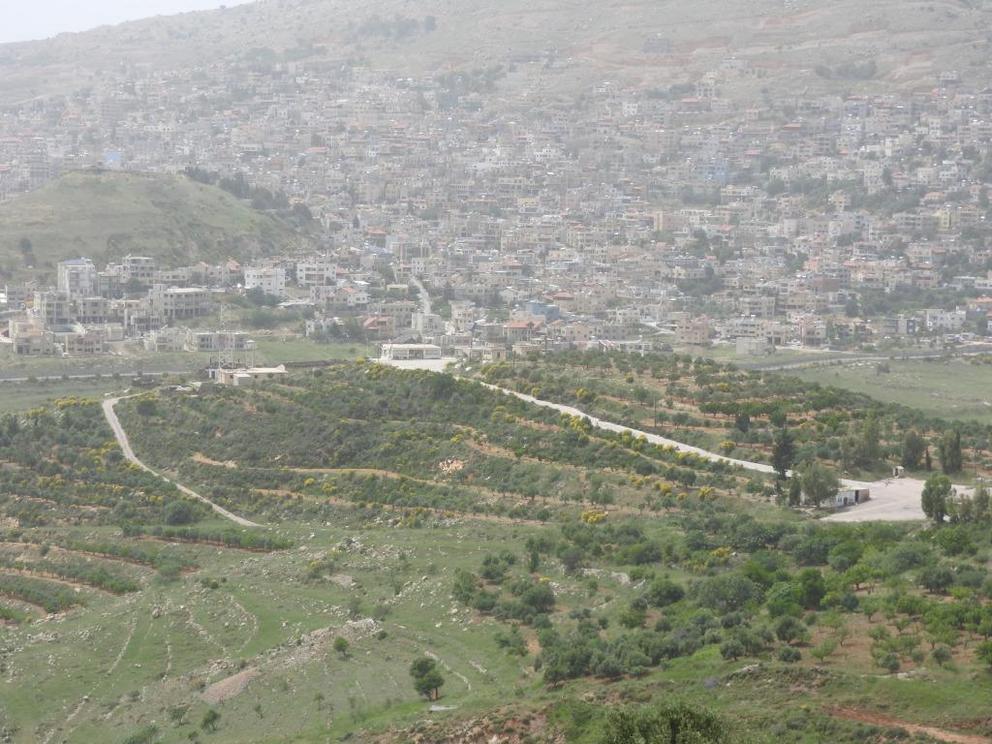
White Building is on “Shouting Hill”, when Syrians on Hadar side communicated with Syrians in occupied Golan’s Majdal Shams. -Eva Bartlett
The hill I stood on, far lower than surrounding hills, was known as the Shouting Valley, because shouting by megaphones was for many years the sole means of communication between Syrians from Hadar and those in Israeli-occupied Majdal Shams.
A February 2014 article in al-Akhbar by Firas Choufi noted:
After the 1973 War, residents of liberated Hadar and occupied Majdal Shams were separated into ‘two banks,’ and since then, they would meet, converse, and share news and concerns by shouting in megaphones, giving the area its name.
…The villages of Majdal Shams, Baqaatha, Masaada, Ain Qanya, and al-Ghajar are in truth the only villages in the Golan still inhabited by their native residents. In the 1967 War, the Israeli occupation ethnically cleansed two cities and more than 300 villages and farms in the Golan, using systematic massacres, bombardment, demolition of homes, and arrests, completely leveling existing villages.
Today, around 23,000 Syrians live in the Golan Heights, and reject Israeli citizenship. They inhabit an area that is no bigger that 7 percent of the total area of the Golan Heights, which represents the primary source of water for occupied Lake Tiberias (Sea of Galilee).
Meanwhile, 10,000 Jewish Israeli settlers live in 45 settlements built atop the ruins of Syrian villages, the largest of which is the settlement of Katzrin, which was built on the ruins of the Syrian town of Qisrin. Recently, the Israeli government officially declared the settlement an Israeli city.”
In the valley to my right, between Jabal al-Sheikh and the hill I stood on, lay farmland belonging to residents living in occupied Majdal Shams. Mahmoud Taweel explained that since the owners can’t cross from occupied Majdal Shams, relatives tend the land for them. He also noted that the lush land roughly two hundred meters from the fence is not workable; it is prohibited. Yet, on the side occupied by Israel, houses and worked farmland extend right up to the fence.
I was again reminded of Gaza, where farmers can’t access fertile land within up to a kilometer along the fence with Israeli-occupied Palestine. This land, the former breadbasket of Gaza, has been forcibly rendered dry and wasted. Israel has systematically destroyed wells and cisterns to ensure that those brave farmers who try to work their land regardless of Israel’s unilaterally and illegally imposed restrictions will find it nearly impossible to grow wheat and vegetables. On the Israeli-occupied side of that Gaza fence, the land is lushly green, irrigated with modern equipment. The same Israeli double-standards apply around the occupied Syrian Golan.
UN condemns then collaborates
The United Nations’ Security Council and General Assembly have long-condemned Israel’s many violations of international law with respect to its occupation of the Syrian Golan Heights, including Israel’s “failure to comply with Security Council resolution 497 (1981)…” That resolution included demanding that Israel rescind its “decision to impose its laws, jurisdiction and administration in the occupied Syrian Golan Heights.”
The UN General Assembly declared:
Israel’s decision of 14 December, 1981 to impose its laws, jurisdiction and administration on the occupied Syrian Golan Heights constitutes an act of aggression under the provisions of Article 39 of the Charter of the United Nations and General Assembly resolution 3314 … Israel’s decision to impose its laws, jurisdiction and administration on the occupied Syrian Golan Heights is null and void and has no legal validity and/or effect whatsoever.”
The UN rightly views Israel’s occupation and annexation of the Syrian Golan Heights as a “continuing threat to international peace and security.”
That Israel essentially has gotten a carte blanche from most Western nations to illegally annex further Palestinian land, occupy Syrian and Lebanese land, and continue murdering Palestinians and attacking Syria is not terribly surprising given the Israeli-UN collaboration in the occupied Syrian Golan, a collaboration notably including al-Qaeda terrorists.
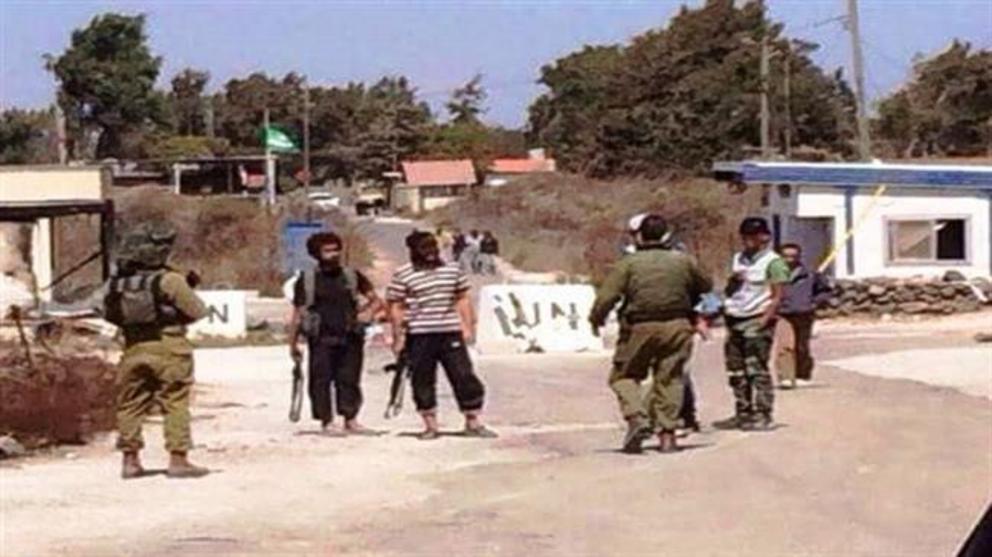
A photo from the Israel, Syrian border along the Golan Heights shows IDF soldiers conversing with al-Qaeda affiliated Jabhat al-Nusra fighters.
On December 22, 2014 Al Akhbar reported:
Observers from the United Nations Disengagement Observer Force (UNDOF) confirmed in a report cooperation and coordination between the Israeli army and militant groups in Syria.
The UNDOF report said that observers witnessed several meetings between rebel leaders and Israeli army forces between December 2013 and March 2014, in addition to witnessing the transportation of hundreds of injured militants to Israeli hospitals following confrontations between the militants and the Syrian army near the occupied Golan border.”
Regarding the November 3, 2017 terrorist attacks on Hadar and surrounding Syrian areas, a UNSC report noted:
Armed groups launched an attack involving heavy machine gun, small arms and indirect fire from the tri-village area of Jubbata al-Khashab, Turunjah and Ufaniyah in the area of separation against pro-Government forces in the vicinity of Hadar, which is largely inhabited by members of the Druze community.
…Preceding the attack, open sources reported that a vehicle-borne improvised explosive device targeted a pro-Syrian forces checkpoint in Hadar, killing nine people.”
But the role of the UN regarding Israel’s interaction with, and support of, terrorists doesn’t end with merely reporting on these facts. The UN also whitewashes the Israeli-al-Qaeda coordination and puts the blame on Syria for defending itself.
As I wrote previously:
In a November 2014 report, the Secretary-General mentioned the presence of al-Nusra and other terrorists in the ceasefire area ‘unloading weapons from a truck,’ as well as a ‘vehicle with a mounted anti-aircraft gun’ and Israeli ‘interactions’ with ‘armed gangs.’ Nonetheless, he went on to condemn strongly the Syrian army’s presence, offering no alternative solution to how to fight against those who fire on Syrian army and civilians from within the UNDOF-deserted area.”
The Syrian Mandela
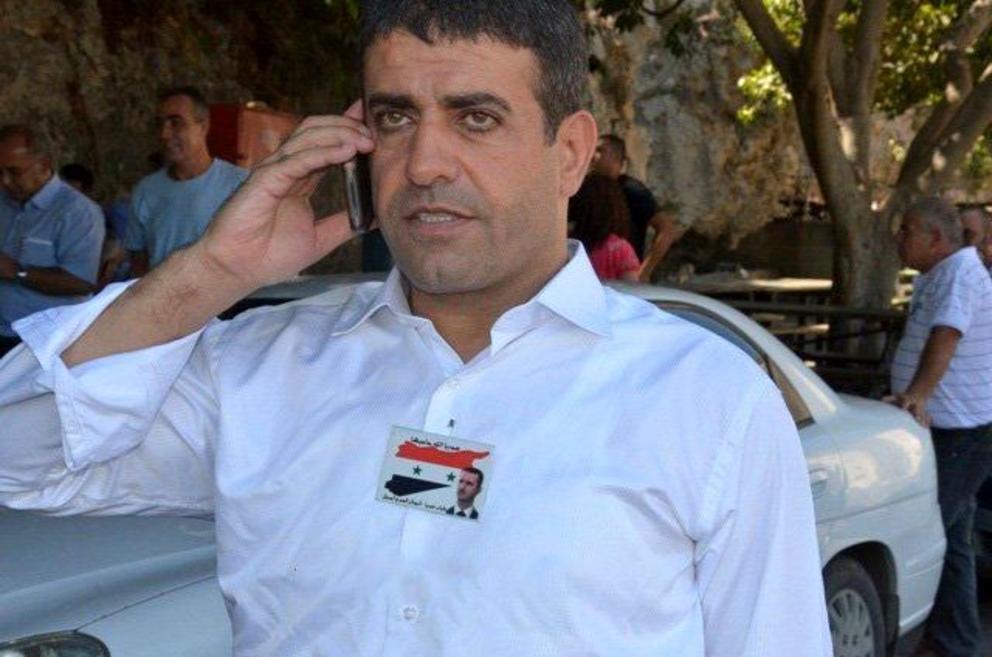
Sedqi al-Maqt was arrested by Israel’s Shin Bet for exposing collaboration between Syrian rebels and Israel.
In April 2017, Syria’s Ambassador to the UN Dr. Bashar al-Ja’afari, speaking on Israel’s occupation of Syrian territory, also said:
We have to call on Israel to free Sedqi al-Maqt—who we call the Syrian Mandela—and others who are in Israeli prisons for taking pictures, taking photos that prove that Israel is cooperating with the al-Nusra Front in the occupied Syrian Golan.”
Maqt is a Syrian in his early 50s from the occupied Syrian Golan who was imprisoned 27 years in Israeli prisons for his resistance to the Israeli occupation of Syrian land. He was released in 2012. Later, Maqt began filming the “joint cooperation between,” as he stated, Israeli soldiers and al-Qaeda terrorists near the Quneitra crossing. He was re-arrested by Israeli secret police in February 2015.
Maqt also reported seeing Israeli forces supplying terrorists with weapons and munitions, and conveyed his feeling that the crossing had been turned into an operations room and safe shelter for terrorists attacking Syria, with the support and knowledge of the Israelis and the UN.
In one of his reports, Maqt noted that, “the terrorists would move with complete freedom,” from the areas they occupied in the Syrian Golan to areas where UN and Israeli forces were present. He noted that when the Syrian army shelled them, al-Qaeda and other terrorists took cover in areas where the Israeli and UN forces were present.
Prior to his 2015 arrest, Maqt also reported on the Israeli field hospitals that are treating terrorists, and reported that residents of the occupied Syrian Golan daily see Israeli ambulances transporting terrorists, and Israeli forces interacting with terrorists:
There’s no way you could bring these terrorists to this field hospital if there wasn’t a joint operations room and daily communication and coordination..between Israeli forces and terrorist commanders.”
Ironically, when Sedqi al-Maqt was arrested, Israel charged him with “terrorism offences.”
When I visited the last couple hundred meters of Syrian land before occupied Majdal Shams, the sight of the vacated UN post, just to my left and before the illegally annexed Majdal Shams, was a visible reminder that Israel — with over 70 UN resolutions condemning it for its genocidal, land-thieving, war-criminal behavior against Palestinians, also including attacks on Syria and Lebanon — continues to evade facing any proper justice, making a farce of the UN and international law.
Hadar villagers speak through tears of terrorism they’ve faced
Just before the main square in Hadar, I met Atef Nakkour, sitting in his small shop. He welcomed me and spoke of Hadar’s defiance:
You are very welcome in Hadar, this resistant village that has provided the invaluable to defend its dignity and freedom, and the dignity of the motherland. We are clinging to our land regardless of who agrees or disagrees.”
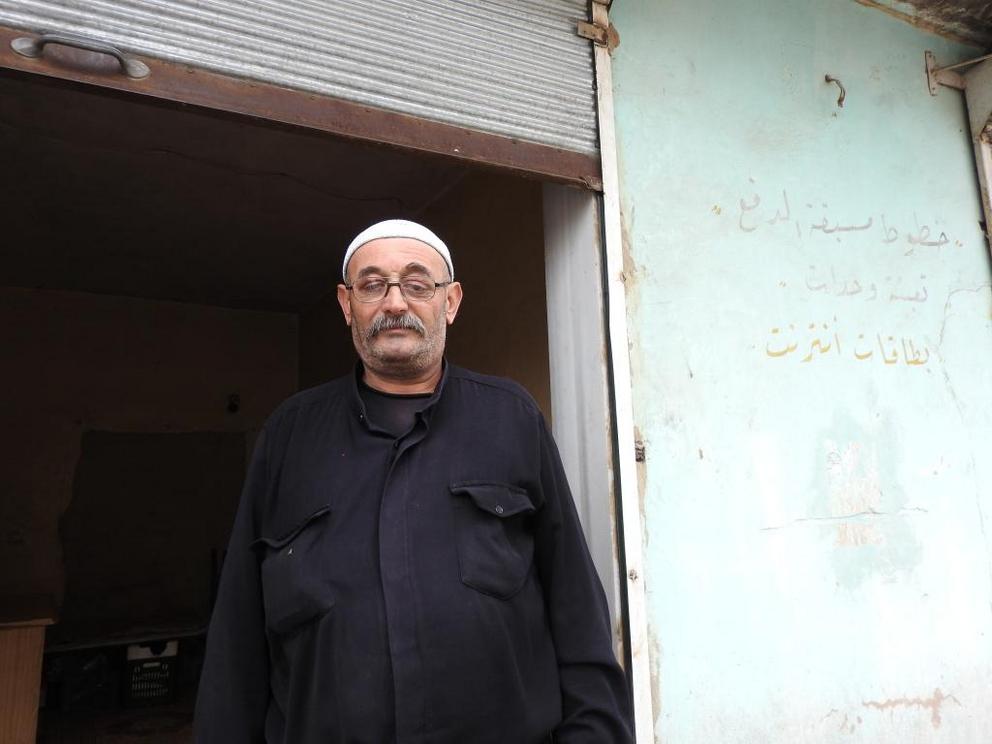
Hadar resident Atef Nakkour, proud supporter of Syrian army and leadership. -Eva Bartlett
He too mentioned at least 130 martyrs from the village, and spoke of Hadar’s gratitude to the Syrian army:
We wholeheartedly endorse our army and our leadership.”
Hadar’s former mukthar (mayor), Jawdat al-Taweel, “Abu Abdu,” is a towering, charismatic man. He is still a popular figure in Hadar, and now runs a clothes shop in town.
He gave me a tour of the destruction from terrorist attacks. We stopped first at an internally-gutted, one-level shop that used to sell dairy and other food products. The shop, run by a family of women, was shelled and its equipment and goods destroyed in September 2017. The women now have no income.
Watch | Jawdat al-Taweel, Hadar’s former mayor, shows damage to homes after terrorist’ shelling
We continued, Abu Abdu pointing out scars of the shellings, in walls and roofs on either side. From around a corner, Atef Nakkour shouted for Abu Abdu to show me his own damaged home. We climbed onto a rooftop and walked to its edge. The former mayor pointed out more damage, the remnants of shelling, and called down to Nakkour, “Where were you standing when it happened?”
Nakkour, standing on the street below us, replied that he’d been standing in the same spot, that a shell landed on a car parked nearby, shrapnel exploding towards the second level, damaging his home. Largely repaired, pockets in the roof overhang evidence the shelling.
Walking down from the square and to a small home surrounded by a stone wall, bushes and flowers, an elderly man and his wife spoke of their murdered son and relative. Mr. Hassoun spoke slowly, and as he described losing his son, Minhal Ahmed Hassoun, both he and his wife next to him began to cry. Through tears, he began:
Yes we lost young men, but we invaded no one, and we had no intention to kill anyone. They came to us on our land, and wanted to kill us and to humiliate us, but our youth and our heroic men preferred martyrdom to humiliation.”
Mahmoud Taweel added that the village men had fought alongside the Syrian army, fighting the terrorists who attack Hadar.
Mr. Hassoun continued:
They [terrorists] came in large numbers, and Israel backed them with artillery, but our men refused to withdraw a meter from their trenches. When the hero Minhal was martyred, his brother was next to him. He closed Minhal’s eyes, and said to him: ‘Your blood is invaluable, and they will pay for what they did.’”
Minhal had been studying law at Damascus University, Mr. Hassoun said:
I told him, ‘My son, finish your studies and get your degree, these battles are long.’ He answered me, ‘My father, the degree dies the moment its holder dies, but martyrdom for the motherland never dies, it lasts for generations.’
He took his wife to Jaramana, to the hospital so that she could give birth. They told him that there were still three or four days until it was her time, but he left his wife with his siblings, and said to her: ‘I want to go, the elders [his parents] are there and I won’t leave them alone.’
He came back in the evening, left for the battle next morning, and was martyred at 8 a.m.”
The newborn baby was named after his martyred father, Minhal.
Watch | Abu Minhal speaks of his son, who was killed defending Hadar
Minhal’s mother, who had been quietly wiping away her tears, listed their losses:
My grandson was the first martyr, his name was Anas. Then after him my son was martyred, his name was Minhal. After him my nephew was martyred, his name was Ismaeel. After that two more nephews of mine were martyred: one was called Hamed and the other one Hasan.”
She finished with a stoic comment reflecting the resilience not only of Hadar but of Syrians in general:
Losing a feather wouldn’t make a bird nude. No matter how many we lose, it’s better than those dogs come here.”
Before leaving, Mr. Hassoun brought out his old rifle and said:
We are following our ancestors’ steps and will never give up our motherland as long as we are alive.”
The terrorist attacks on Hadar and its farmland continue to the shrugs of Western corporate media precisely because reporting on such devastation by what the same media sells us as “rebels” would once again shatter the myth of “moderates,” the myth of a “revolution,” and of a “civil war.”
In addition to Hadar’s strategic position, the people of Hadar are being attacked because they stand with their army and president. But after years of such attacks, and after over 130 martyrs, it is clear Hadar villagers have no intention of changing their stance, much like defiant Syrians throughout Syria.
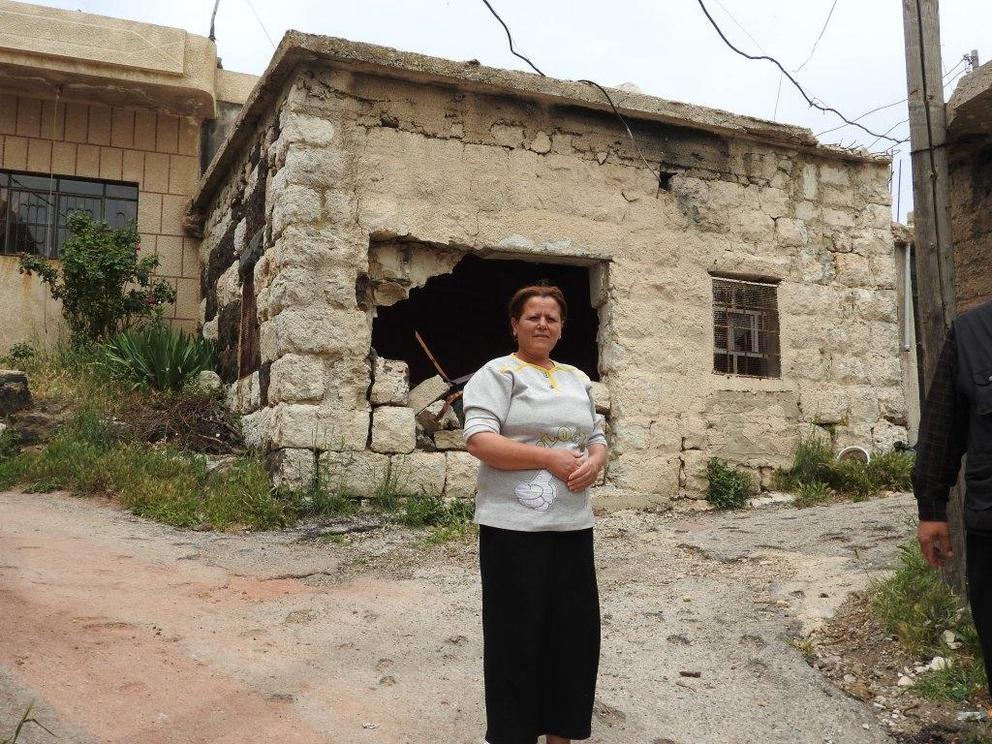
Now unemployed Hadar resident outside her former food and dairy shop destroyed in terrorist shelling in September 2017 -Eva Bartlett
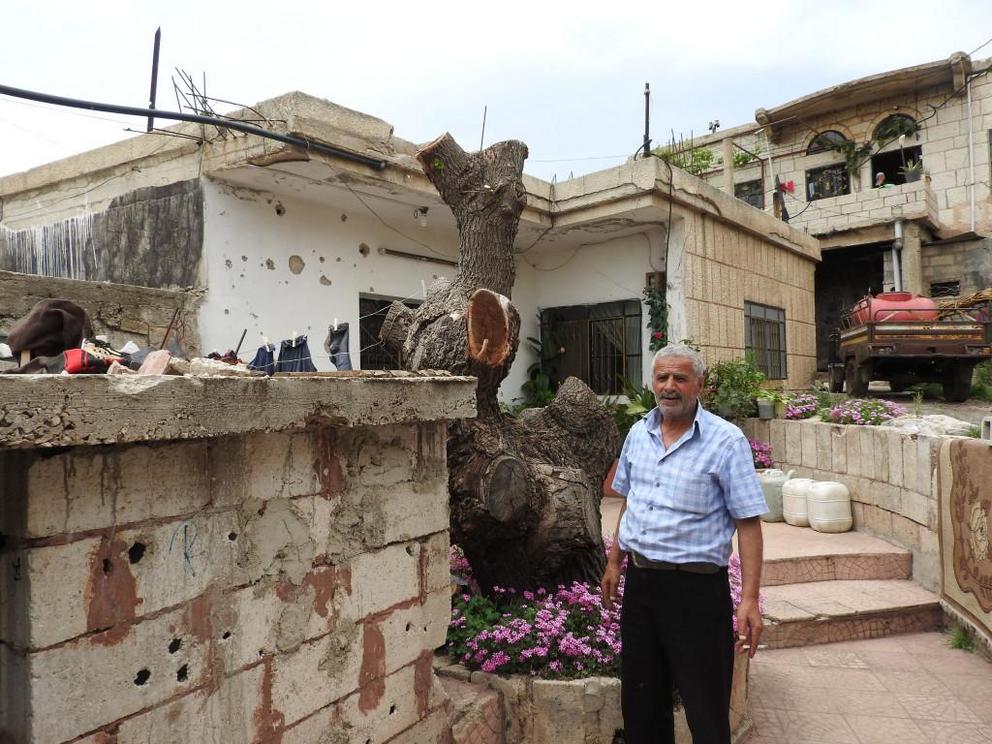
A Hadar resident stands outside of his shrapnel damaged home. Eva Bartlett | MintPress News
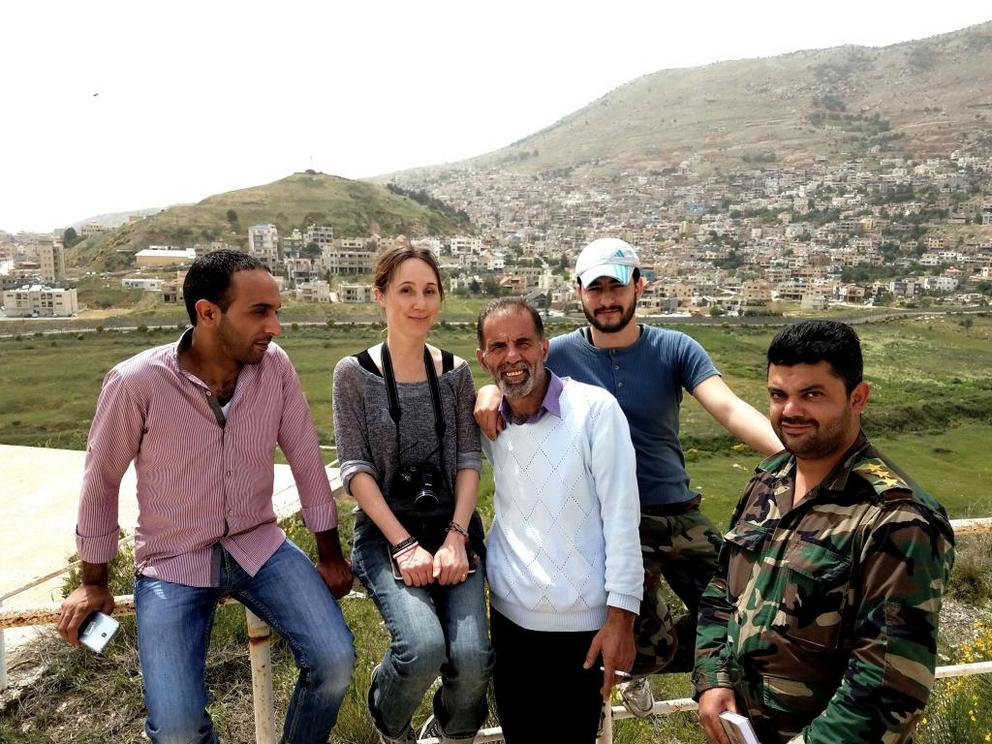
The author. To the left of this frame, some kilometres south, al-Qaeda occupied Jubata al-Khashab and attacks Hadar.
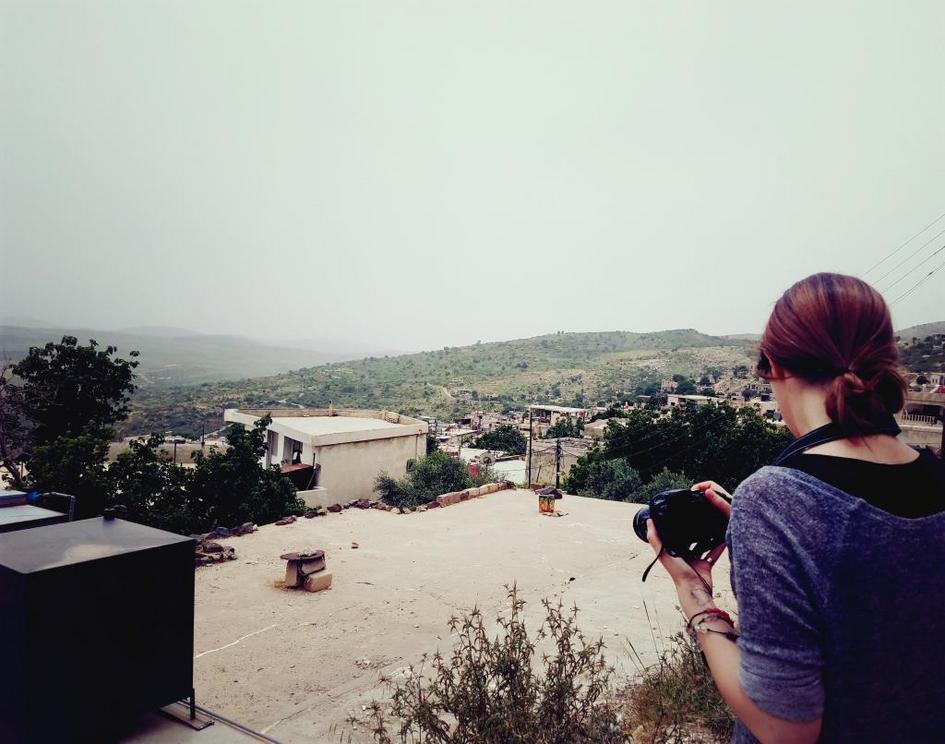
At occupied Majdal Shams, with Hadar resident Mahmoud Taweel, my hired taxi driver, and two Syrian soldiers who accompanied me to ensure my safety from al-Qaeda terrorists off the road to Hadar.
Related articles:
–Absurdities of Syrian war propaganda
–Scoundrels & gangsters at UN: Silencing the Syrian narrative
